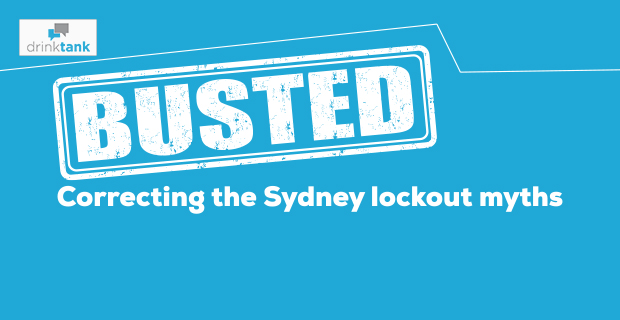A new report aimed squarely at busting the myths surrounding New South Wales’ lockouts and last drinks, aims to once again put the research evidence at the forefront of the debate.
And that’s important.
With the Callinan Inquiry likely to hand its report to Government in coming days, a desperate alcohol industry is once again on the offensive.
Opposed to the life-saving measures, based on a combination of vested personal and financial interests, but without the benefit of evidence to make its case, the alcohol industry and noisy Keep Sydney Open advocates turn instead to unsubstantiated opinion. No matter how false or deliberately misleading.
And that’s unacceptable. In a debate so crucial we should demand all claims made be informed, supportable and truthful.
We should demand that those opinions are interrogated and critiqued with scientific rigour. Not blindly accepted at face value and thereafter repeated as ‘fact’.
We should demand that the agendas of vested interests be openly and honestly disclosed.
For instance, in this new report from the Foundation for Alcohol Research and Education (FARE), Correcting the Sydney lockout myths, we make no apologies about our background and intent. FARE is a not-for-profit organisation interested in stopping the harm caused by alcohol and we are passionate about advocating for evidence-based policy that will achieve this.
The report adds some common sense and perspective back in to what has become an emotive anecdotal debate – investigating and effectively dismissing five oft-repeated mistruths surrounding the measures introduced in Kings Cross and the Sydney CBD in 2014.
The alcohol industry has attempted to paint a picture of a city that’s empty, businesses shuttered, employment prospects bleak, property values in decline, alcohol-related harm still unchecked, and spilling into adjoining neighbourhoods.
Except that is a complete fiction, a city that exists only in their minds.
Importantly, FARE’s report relies solely on the most up-to-date evidence – a variety of robust and reputable data sources from the City of Sydney, the NSW Valuer General, and the NSW Bureau of Crime Statistics and Research (BOCSAR) – to assess the veracity of claims and ultimately debunk those that don’t stand up to the scrutiny.
Let’s begin with the false ‘ghost town’ narrative. This relies on a claim that foot traffic in Kings Cross between 5pm and 4am on Saturday nights has declined by 80 per cent. Wrong! The average decline is in fact only 19.4 per cent.
Those opposed to the lockouts have also wildly exaggerated the number of business closures resulting from the Sydney measures – with a fondness, but no evidence, for repeatedly suggesting the number is 40. Wrong again! The reality? There are only four fewer businesses trading between 5pm and 4am on Friday or Saturday nights in Kings Cross (from 170 in 2012 to 166 in 2015).
The story is the same when examining the impact on property values, with anti-lockout advocates misrepresenting the extent of the decline and failing to acknowledge significant increases in property values. Between 2014 and 2015, mixed use property values in Woolloomooloo, Potts Point, Elizabeth Bay, and Darlinghurst actually rose 15 per cent. Meanwhile residential property values in The Bays and Potts Point rose 35 per cent.
Some would have you question how effective the package of measures have been in reducing alcohol harms. Yet, the evidence is overwhelming.
Fact: the rate of non-domestic assaults during the lockout period on weekends has reduced by 70.2 per cent in Kings Cross and 30.7 per cent in the Sydney CBD. Following last drinks at 3am, the assault figures are 75.5 per cent and 41.5 per cent respectively.
Then there’s the claim of displacement of harm, the unfounded assertion that the violence has simply been shifted to a neighbouring locale. Not true! Assaults in surrounding entertainment precincts have remained stable since the introduction of the measures.
The alcohol industry and those forces aligned in opposition to the successful and modest liquor law reforms must hope that an often repeated assertion will become accepted as fact.
They must believe that in an age of celebrity, that proof and evidence are inconvenient and unnecessary.
They must believe that the people of New South Wales have a short memory and have forgotten how bad things were before steps were taken to make Sydney safer.
They’d be wrong on that score. New polling published by The Sydney Morning Herald yesterday found majority support for an extension of the 1:30am lockout and 3am last drinks across the state, and broad community support for retaining the measures, including among young people.
Or perhaps the alcohol industry still believe that arguments can be won by those that shout the loudest.
How did Keep Sydney Open’s Tyson Koh respond to the FARE report? Faced with the inconvenient truth – independent data from the City of Sydney, the NSW Valuer General, and the NSW Bureau of Crime Statistics and Research (BOCSAR) – Tyson said “You simply cannot print that garbage” (The Sydney Morning Herald, page 4, 29 August 2016).
Koh and his industry cohorts have every reason to sound frustrated. Their campaign, built on the appearance of popular support, and attempts to undermine evidence with nothing more than unsubstantiated claims, is in tatters.
It’s not just being successfully challenged.
It’s being recognised, and deservedly so, for the myth it represents.








11 comments